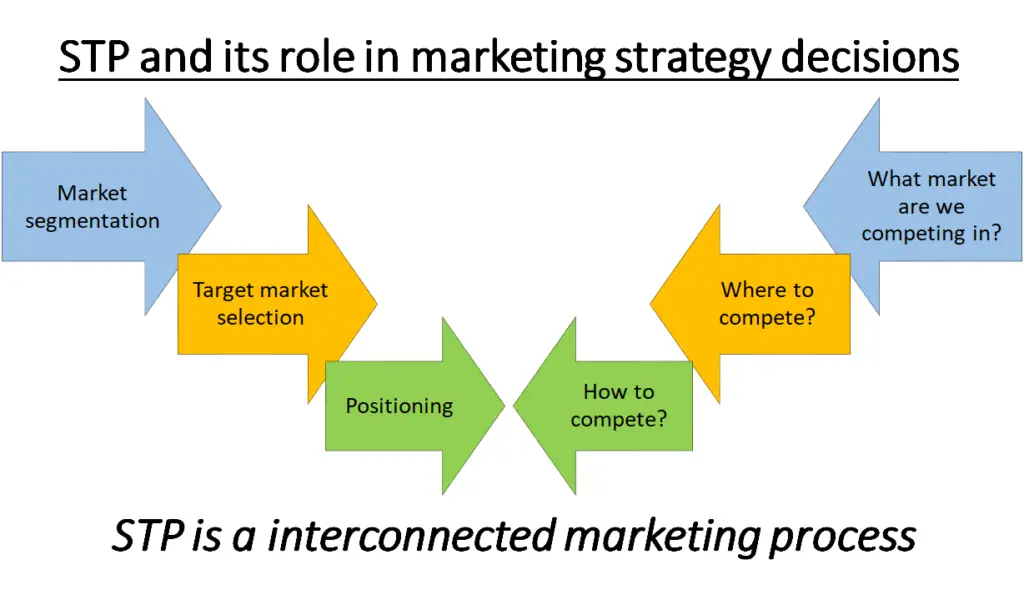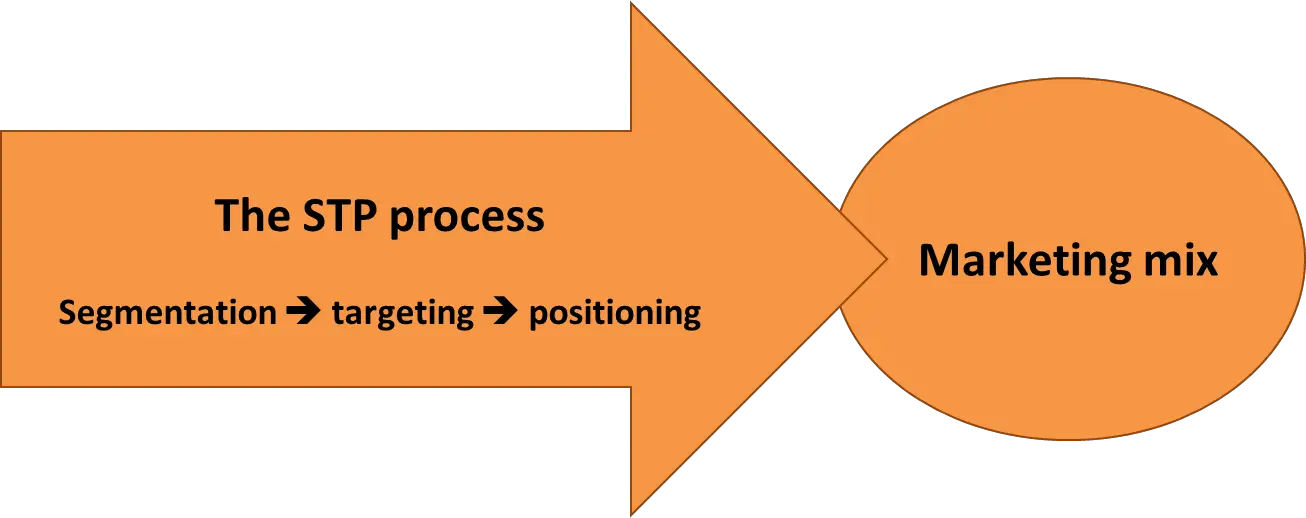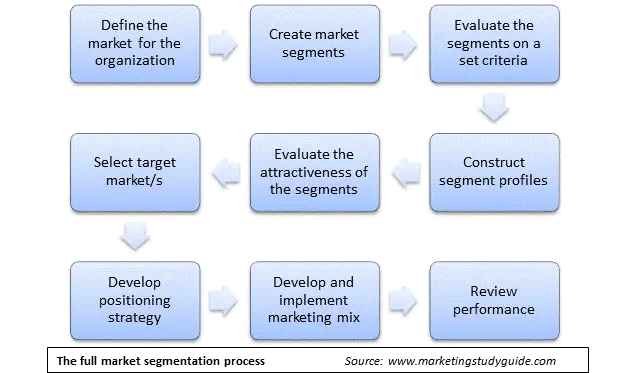Contents
About the STP Process in Marketing
When you explore the world of modern marketing, you’ll quickly discover that the STP marketing process is a crucial component. Essentially, STP (Segmentation, Targeting, and Positioning) defines how brands and their product offerings compete in the marketplace.
It achieves this by identifying relevant and attractive market segments for your organization, followed by developing a suitable product positioning—meaning how you intend consumers to understand your brand’s key benefits.
It’s important for you, especially if you’re a university student or new marketer, to understand the STP model. It serves as the foundation for grasping the connection between market segmentation, target market selection, and product positioning—three interlinked concepts that also connect to an organization’s broader marketing strategy.
In some marketing textbooks, the STP process is essentially that textbook’s description of how to construct marketing strategy – as target market selection and positioning are key strategic decisions for a brand.
Please note that STP is sometimes broken into STDP in some marketing textbooks as well, where the D stands for differentiation. However, differentiation is essentially a component of positioning. You can read about the STDP process here.
Be sure to watch the two videos on the STP process at the bottom of this article for a quick overview.
STP is a Linked and Integrated Process
You’ll often hear that the steps in STP—segmentation, targeting, and positioning—form a sequential process: you segment your market, then pick one or more target markets, and finally implement the desired positioning.
Even though the letters S, T, and P highlight three distinct ideas in marketing, they actually operate as one integrated framework. Together, they inform your high-level marketing strategy, which you then put into action through the marketing mix.
The goal of the STP process is to guide the organization to the development and implementation of an appropriate marketing mix, as highlighted in the following diagram.
The main point here is that STP helps you refine the design of your marketing mix. In other words, how you structure your marketing mix collectively shapes the product’s positioning, making it attractive to your chosen target market.
STP Addresses Key Strategic Marketing Questions
rom a strategic perspective, STP helps you answer several fundamental questions:
Where to compete?
- You answer this by segmenting a defined market and then selecting which segments to target.
How to compete?
- You address this by formulating a positioning strategy and supporting it with a compatible marketing mix.
 As you can see from the above diagram, the STP marketing process progressively defines the marketing strategy decisions for a firm. At the outset, the firm needs to consider what market they are competing in – which is addressed by the segmentation of a defined market.
As you can see from the above diagram, the STP marketing process progressively defines the marketing strategy decisions for a firm. At the outset, the firm needs to consider what market they are competing in – which is addressed by the segmentation of a defined market.
The market segmentation task allows attractive and viable segments to be identified, which then allows the firm to further fine-tune its marketing decisions and answers the question “where to compete?” And the final part of the STP process is identification of a suitable positioning for the product or brand within the selected target market – which answers the question “how to compete?”
Basic vs. Full STP Marketing Process
When you’re studying STP, you’ll come across two primary ways to understand it: a basic model and a full model with multiple steps.
The Basic STP Process
The introductory model simply uses the three letters of STP to highlight the core elements of the process, namely segmentation, targeting and positioning.
The basic STP process involves three broad steps:
- Segmentation: Identifying potential market segments based on shared traits or needs.
- Targeting: Evaluating the attractiveness of these segments and selecting those to target.
- Positioning: Designing the brand’s image and messaging to appeal to the selected segments.
This simplified version is a helpful introduction for students and practitioners new to the STP framework. This approach is shown in the following diagram and discussed further in the Basic STP Process article.
The Full STP Process
While this basic model is a good starting point for understanding the overall process, there are a number of smaller steps that should also be understood, which are outlined in the following diagram and discussed in the Full STP Process. By reviewing this more detailed approach, students will gain a much greater understanding of this important marketing concept.
The full nine-step STP process is:
- Define the Market: Clearly identify the overall market scope and focus.
- Create Market Segments: Use segmentation bases (e.g., demographics, behavior) to form distinct groups.
- Evaluate Segment Viability: Assess each segment’s size, accessibility, and alignment with the business strategy.
- Construct Segment Profiles: Develop detailed descriptions of each segment, including demographics, needs, and behaviors.
- Evaluate Attractiveness: Analyze the potential profitability and competitiveness of each segment.
- Select Target Markets: Choose one or more segments to serve as the focus of marketing activities.
- Develop Positioning Strategy: Create a unique positioning statement that differentiates the brand or product.
- Design Marketing Mix: Tailor the product, price, place, and promotion to reinforce the positioning.
- Review Performance: Regularly evaluate outcomes and refine the strategy as needed.
The advantage of the above nine step STP process in marketing is that it provides some details and clearer steps on what the marketer has to do to work through the process.
In addition to the three basic STP steps, the above diagram makes it clear that firms need to firstly define their overall market, and then after the segments are identified they need to be evaluated for their effectiveness and segment profiles then need to be developed.
Following that, the most attractive and appropriate market segments for the firm are selected to be their target market/s. And you will note, that following the development of their positioning strategy, then the marketing mix is then designed around the needs of the target market and the desired product positioning.
Please review the article on the full steps of the STP process in marketing. And also review the article on STDP = segmentation, targeting, differentiation and positioning.
STP as the Foundation of Marketing Strategy
Because the STP process ensures you’re matching your offerings to specific consumer needs, it’s central to modern marketing success. By honing in on the right segments, you’ll more effectively align your product or service with the individuals most likely to value it—giving you a clearer path toward competitive advantage.
Benefits of the STP Process:
- Strategic Clarity: Ensures businesses focus resources on the most promising market opportunities.
- Differentiation: Helps brands stand out in competitive markets by emphasizing unique benefits.
- Customer-Centricity: Aligns marketing efforts with the specific preferences and behaviors of target consumers.
Recap: Definitions of Segmentation, Targeting and Positioning
Market segmentation can be defined as:
- The process of splitting a market into smaller groups with similar product needs or identifiable characteristics, for the purpose of selecting appropriate target markets.
Targeting (or target market selection) refers to:
- An organization’s proactive selection of a suitable market segment (or segments) with the intention of heavily focusing the firm’s marketing offers and activities towards this group of related consumers.
And positioning (which is sometimes referred to as product positioning) is:
- Positioning is the target market’s perception of the product’s key benefits and features, relative to the offerings of competitive products.
FAQs on the STP Marketing Process
What is the STP marketing process?
- The STP process stands for Segmentation, Targeting, and Positioning. It is a marketing framework used to divide a market into smaller segments, choose specific target markets, and position products to appeal to those markets. It guides businesses in developing focused and effective marketing strategies.
Why is the STP process important in marketing?
- The STP process helps businesses create tailored strategies that resonate with specific consumer needs. It ensures resources are directed towards the most attractive opportunities and helps differentiate brands in competitive markets.
What is the difference between the basic and full STP process?
- Basic STP Process: The basic model consists of three broad steps:
- Segmentation: Identify potential market segments.
- Targeting: Choose segments to focus on.
- Positioning: Develop strategies to appeal to those segments. It offers a high-level framework ideal for introductory understanding.
- Full STP Process: The full process includes nine detailed steps, such as defining the market, constructing detailed segment profiles, and developing a customized marketing mix for each target market. This comprehensive approach provides a more granular understanding and guides more strategic decision-making.
What is the difference between segmentation and targeting?
- Segmentation involves dividing the market into smaller, more defined groups based on shared characteristics (e.g., demographics, behavior). Targeting refers to evaluating these segments and selecting one or more to focus marketing efforts on.
What is the relationship between differentiation and positioning?
- Differentiation involves identifying unique product attributes that set a brand apart from competitors. Positioning communicates these attributes to the target market, shaping their perception of the brand’s value relative to competitors.
What are some common segmentation bases used in the STP process?
- Common segmentation bases include:
-
- Demographic: Age, gender, income, education.
- Psychographic: Lifestyle, values, personality.
- Behavioral: Usage rate, brand loyalty, purchase behavior.
- Geographic: Region, climate, population density.
-
How does the STP process help businesses decide where and how to compete?
- The STP process helps businesses determine where to compete by identifying market segments through segmentation and evaluating their attractiveness during the targeting phase. It answers the “where” question by selecting target markets that align with the company’s strategic goals and resources.
The “how to compete” question is addressed in the positioning phase, where businesses develop strategies to differentiate their offerings and create compelling value propositions for their selected target markets. Positioning determines how the brand will stand out in the competitive landscape.
Helpful Videos
Academic Readings



